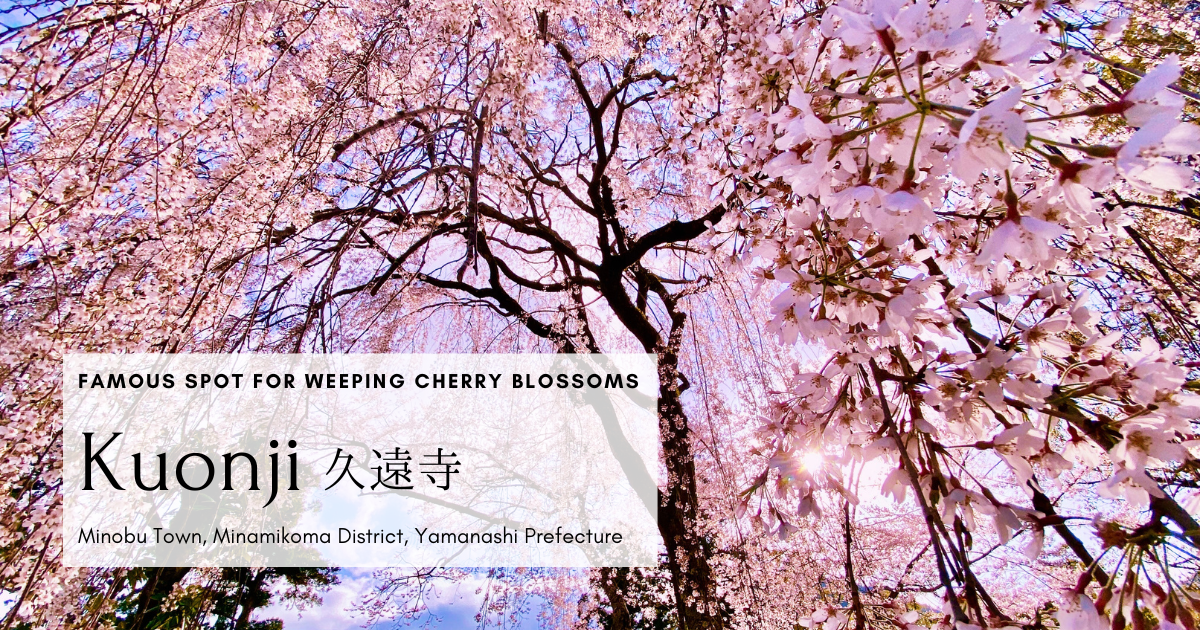Minobusan Kuonji Temple

Minobusan Kuonji Temple, located in Minobu Town, Minamikoma District, Yamanashi Prefecture, is the head temple of Nichiren Buddhism. The temple’s mountain name is “Minobusan,” and its temple name is “Kuonji.”
This is the sacred place where Nichiren Shonin, the founder of Nichiren Buddhism, settled in 1274 after leaving Mount Hiei. He dedicated his life to spreading the teachings of the Lotus Sutra at this location. Nichiren Shonin spent nine years at Minobusan, training many disciples.
The temple grounds feature numerous sacred sites, including the remains of Nichiren Shonin’s grass hermitage, the Go-shin-kotsu-do Hall where his ashes are enshrined, and the mausoleum marking the site of his passing.
- Visiting hours
- Summer Hours (April–September): 5:00 am AM – 4:55 am PM
- Winter Hours (October–March): 5:30 am AM – 4:55 am PM
- Regular holiday
- Open year - round
- Telephone number
- +081-556-62-1011
- Parking
- Paid parking available nearby
- Address
- 3567 Minobu, Minobu Town, Minamikoma District, Yamanashi Prefecture, 409 - 2593, Japan
Minobusan Kuonji Temple - Official Website
Stunning! The Enormous Weeping Cherry Tree
The weeping cherry tree at Minobusan Kuonji Temple is a majestic tree over 400 years old and has been selected as one of Japan’s Top 10 Weeping Cherry Trees.

Weeping cherry trees are characterized by their drooping branches, creating a soft and gentle impression. The weeping cherry tree at Kuonji Temple is particularly famous for its massive size and unparalleled beauty, attracting countless visitors every year.

The tree reaches its peak bloom from late March to early April, during which the temple grounds are bathed in shades of pink.

The most striking feature of the weeping cherry tree is its graceful appearance. The drooping branches create a curtain of blossoms, and the sight of petals dancing in the wind is truly mesmerizing.

Thus, the weeping cherry tree at Kuonji Temple is not only a sacred symbol of Nichiren Buddhism but also a celebrated cherry blossom viewing spot in Japan.
Main Hall
The main hall of Kuonji Temple is an impressive wooden structure, reconstructed in 1985, showcasing the architectural style of the Kamakura period. It measures 53 meters in height, 33 meters in width, and 45 meters in depth.


Sanmon Gate & Bodaitei Stairs
The temple features a grand Sanmon Gate and the Bodaitei stairs, a stone staircase of 287 steps leading up to the main hall.


After passing through the Sanmon Gate, visitors reach a serene path leading to the Bodaitei stairs.

The path culminates in the Bodaitei stairs, composed of 287 steps.

Divided into seven sections, symbolizing the seven characters of the mantra “Nam Myoho Renge Kyo,” the stairs represent the path to enlightenment upon reaching the top.

At the end of the staircase lies the magnificent main hall.
Parking Information
Several parking options are available for visitors, making it easier to explore the temple based on individual needs and preferences.
For those wanting to walk the Sanmon Gate and Bodaitei Stairs
Park at the “Kuonji Sanmon Free Parking Lot.”

For those who find it difficult to climb stairs or wish to use the ropeway
For easier access, park at the “Seishin Parking Lot.”
Though it is a paid parking lot, visitors can use an elevator to reach the temple directly, avoiding stairs and steep slopes.


Additionally, the Seishin Parking Lot connects directly to the ropeway station, making it convenient for those who wish to take the ropeway to the summit of Minobusan.

The Pinnacle of Japan’s Cherry Blossom Beauty
The weeping cherry tree at Minobusan Kuonji Temple epitomizes the breathtaking beauty of Japan’s cherry blossoms.

Standing over 400 years old, the tree reaches a height of approximately 30 meters, with branches spreading about 20 meters wide. Its cascading branches resemble a curtain of flowers, exuding elegance beyond words.

The blossoms are single-petaled and pale pink in color. The sight of the petals fluttering in the wind is enchanting and leaves viewers in awe.

The cherry blossoms as seen from the ropeway are equally stunning.


The best time to visit is from late March to early April. Be sure to experience this magnificent sight at Kuonji Temple.
